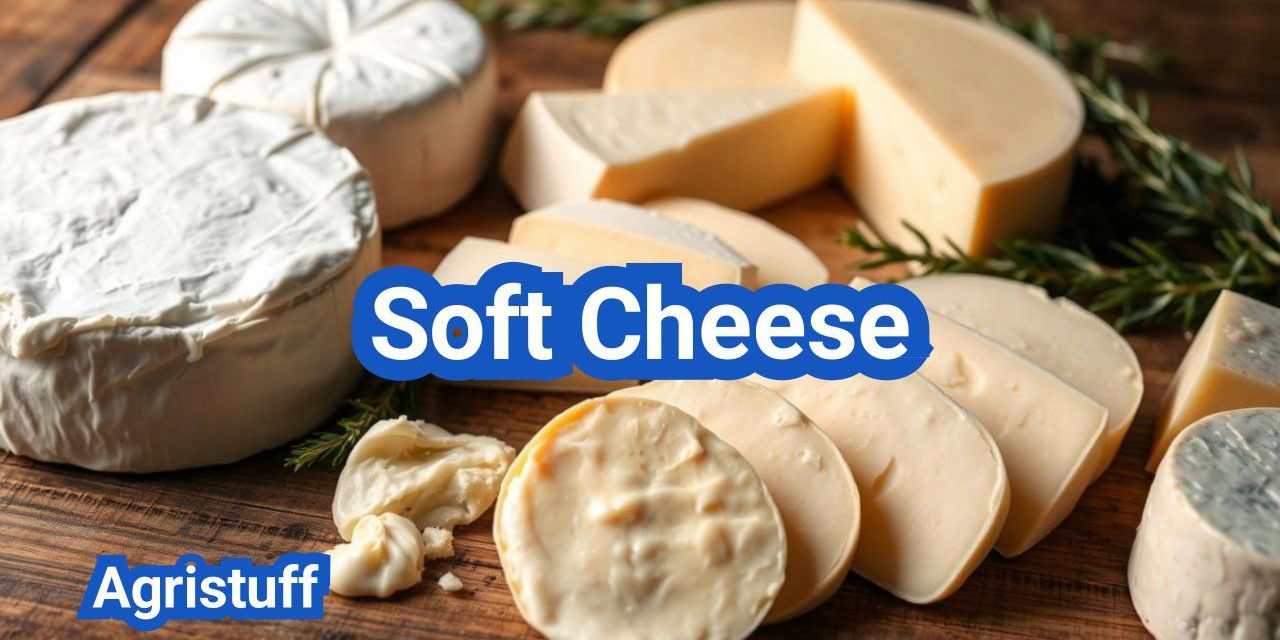Dairy products have been a staple in many cuisines around the world, and soft cheeses are among the most versatile and beloved. Characterized by their creamy texture and mild flavors, these cheeses are often used in spreads, sauces, and desserts.
The production of soft cheeses involves a range of techniques, from aging to fermentation, resulting in a diverse array of types and flavors. Soft-ripened cheeses, fresh cheeses, and some blue cheeses fall under this category, offering a rich experience for cheese enthusiasts.
Understanding the meaning, characteristics, and uses of these cheeses can enhance culinary creations and appreciation for this dairy delight.
Key Takeaways
- Soft cheeses are characterized by their creamy texture and mild flavors.
- Production techniques include aging and fermentation.
- Types of soft cheeses include soft-ripened, fresh, and some blue cheeses.
- Soft cheeses are versatile and used in various dishes.
- Understanding soft cheese can enhance culinary creations.
What Is Soft Cheese? Definition and Origin
With its origins tracing back to ancient times, soft cheese has evolved into a diverse category with numerous types and flavors. Soft cheese is known for its high moisture content, which distinguishes it from harder cheeses and makes it more prone to spoilage.
Historical Background of Soft Cheese
The history of soft cheese dates back thousands of years, with evidence of its production found in ancient civilizations. Soft cheeses were likely first made by nomadic tribes who carried milk in animal stomachs, which contained rennet that caused the milk to curdle.
As civilizations developed, so did the techniques for making soft cheese. The ancient Greeks and Romans were known to produce soft cheeses, and their methods were later refined in Europe, particularly in France and Italy, where many soft cheese varieties originated.
Modern Definition of Soft Cheese
Today, soft cheese is defined by its high moisture content and soft texture. Unlike hard cheeses, soft cheeses have a higher water content, which makes them more delicate and susceptible to spoilage. Soft cheeses can be made from cow’s, goat’s, or sheep’s milk, and they can be categorized into various types based on their production methods and aging processes.
The modern definition of soft cheese encompasses a broad range of cheeses, from fresh, spreadable cheeses like cream cheese to soft-ripened cheeses like Brie and Camembert.
Distinguishing Features of Soft Cheese
Soft cheeses are distinguished by several key features, including their high moisture content, soft texture, and often, a white or light-colored rind. The rind can be bloomy, as in the case of Brie, or washed, as with cheeses like Limburger.
The flavor profiles of soft cheeses can vary widely, from mild and creamy to strong and pungent, depending on the type of milk used, the production methods, and the aging process.
Key Characteristics of Soft Cheese

Understanding the characteristics of soft cheese is essential for appreciating its diverse types and uses. Soft cheeses are known for their high moisture content, which significantly influences their texture and flavor.
Moisture Content and Texture
Soft cheeses typically have a high moisture content, ranging from 55% to 80% of their dry weight. This high moisture level contributes to their characteristic soft and spreadable texture. The texture can vary from creamy to crumbly, depending on the type of soft cheese.
Moisture Content Comparison: To illustrate the variation in moisture content among different soft cheeses, consider the following table:
| Type of Soft Cheese | Moisture Content (%) | Texture |
|---|---|---|
| Brie | 60-70 | Creamy |
| Cottage Cheese | 75-80 | Curdy |
| Cream Cheese | 55-65 | Spreadable |
Aging Process and Ripening
The aging process and ripening of soft cheese significantly impact its flavor and texture. Some soft cheeses are consumed fresh, while others are aged for a period that can range from a few weeks to several months. The aging process involves the action of bacteria and molds that break down the cheese’s fats and proteins, developing its characteristic flavor and texture.
Flavor Profiles of Soft Cheeses
Soft cheeses exhibit a wide range of flavor profiles, from mild and creamy to strong and pungent. The flavor is influenced by factors such as the type of milk used, the aging process, and any additional ingredients. For example, cheeses like Brie and Camembert have earthy flavors due to their white mold rind, while cheeses like Gorgonzola have a tangy, slightly sweet flavor.
Exploring Flavor Profiles: The diversity in flavor profiles among soft cheeses makes them versatile for various culinary applications, from spreads and dips to desserts and main courses.
Understanding Soft Cheese Types and Categories
Soft cheeses are classified into distinct types, including fresh, bloomy rind, washed rind, and soft ripened, based on their production processes and aging techniques. This classification helps in understanding the diverse characteristics and uses of soft cheeses in various culinary contexts.
Fresh Soft Cheeses
Fresh soft cheeses are made from curdled milk that has not been aged. They have a soft, creamy texture and mild flavor. Examples include Cottage cheese, Ricotta, and Cream cheese. These cheeses are often used in spreads, desserts, and as ingredients in cooking.
Bloomy Rind Cheeses
Bloomy rind cheeses are characterized by their white rind, which develops from the growth of mold during the aging process. They have a soft, creamy interior and a mild, earthy flavor. Brie and Camembert are well-known examples of bloomy rind cheeses. These cheeses are typically served as a delicacy and paired with fruit and crackers.
Washed Rind Cheeses
Washed rind cheeses are aged in a brine solution, which promotes the growth of bacteria on their surface. This process gives them a distinctive orange or red rind and a strong, pungent aroma. Examples of washed rind cheeses include Limburger and Epoisses. These cheeses are often served as a strong accompaniment to robust foods.
Soft Ripened Cheeses
Soft ripened cheeses are made using a combination of techniques that involve both the interior and the rind of the cheese. They are aged until they become soft and runny, with a rich, complex flavor. Brie can also be classified under this category, as it ripens from the outside in. Soft ripened cheeses are enjoyed for their luxurious texture and deep flavors.
| Soft Cheese Type | Description | Examples |
|---|---|---|
| Fresh Soft Cheeses | Soft, creamy, mild flavor | Cottage Cheese, Ricotta, Cream Cheese |
| Bloomy Rind Cheeses | White rind, soft interior, earthy flavor | Brie, Camembert |
| Washed Rind Cheeses | Orange/red rind, strong aroma | Limburger, Epoisses |
| Soft Ripened Cheeses | Soft, runny, complex flavor | Brie, other ripened soft cheeses |
The Science Behind Soft Cheese Making

The science behind soft cheese making is a fascinating blend of microbiology, chemistry, and culinary expertise. Soft cheese production involves a complex series of biochemical reactions and physical transformations that turn milk into a variety of cheeses with unique textures and flavors.
Essential Ingredients for Soft Cheese
The basic ingredients for soft cheese making include milk, bacterial cultures, rennet, and salt. The quality and type of these ingredients can significantly affect the final product. For instance, the fat content in milk influences the cheese’s richness and texture, while different bacterial cultures can impart unique flavors.
Milk is the primary ingredient, and its composition varies depending on the source animal (cow, goat, sheep) and the fat content. Bacterial cultures are added to convert milk sugar (lactose) into lactic acid, lowering the pH and beginning the cheese-making process. Rennet, an enzyme, helps to coagulate the milk, separating it into solid curds and liquid whey. Salt is used for flavor and as a preservative.
The Role of Bacteria and Molds
Bacteria and molds play a crucial role in soft cheese production, contributing to the cheese’s flavor, texture, and appearance. Bacteria such as Lactococcus lactis subsp. lactis and Lactococcus lactis subsp. cremoris are commonly used for lactic acid production. Molds, like Penicillium candidum, are used in cheeses such as Brie and Camembert to create a white rind and develop the cheese’s characteristic flavor.
The type and strain of bacteria or mold used can significantly influence the final product. For example, washed-rind cheeses are treated with bacteria like Brevibacterium linens, which gives them a distinctive orange color and strong aroma.
Curdling and Coagulation Process
The curdling and coagulation process is critical in soft cheese making. Rennet is added to the milk to initiate coagulation, causing it to separate into curds and whey. The curds are then cut, stirred, and sometimes heated to release more whey and create a smoother texture.
The coagulation process can be influenced by factors such as temperature, pH, and the amount of rennet used. For soft cheeses, the curds are typically not pressed, allowing them to retain a high moisture content and resulting in a soft, spreadable texture.
Step-by-Step Guide to Making Soft Cheese at Home
Making soft cheese at home is a simple and rewarding process that requires minimal equipment and ingredients. With this guide, you’ll learn how to create delicious soft cheese in the comfort of your own kitchen.
Equipment and Ingredients Needed
To start making soft cheese, you’ll need some basic equipment and ingredients. The essential equipment includes a large pot, a thermometer, cheesecloth or butter muslin, and a colander. For ingredients, you’ll need milk, cheese cultures, rennet, and salt.
The type of milk you use can vary depending on the type of cheese you’re making. Whole milk is often preferred for its rich flavor and creamy texture. Cheese cultures are added to convert the milk sugar (lactose) into lactic acid, which is crucial for developing the cheese’s flavor and texture.
| Equipment | Purpose |
|---|---|
| Large Pot | For heating the milk to the appropriate temperature |
| Thermometer | To monitor the temperature of the milk |
| Cheesecloth or Butter Muslin | For draining the curds and shaping the cheese |
| Colander | To hold the cheesecloth and curds |
Basic Fresh Soft Cheese Recipe
Here’s a simple recipe for fresh soft cheese: Combine 1 gallon of whole milk with 1/4 cup of cheese cultures in a large pot. Heat the mixture to 86°F (30°C), then hold the temperature for 45 minutes. Add 1/4 tsp of rennet and stir gently for about 30 seconds. Allow the mixture to coagulate for 30-40 minutes, or until it has set.
Cut the curds into 1/2-inch pieces and let them sit for 10 minutes. Then, gently stir the curds and transfer them to a colander lined with cheesecloth. Drain the curds for several hours until they reach the desired consistency.
“The art of cheese making is a patience-driven process, and the reward is well worth the wait.”
Unknown
Troubleshooting Common Issues
Common issues when making soft cheese include curds that are too soft or too firm, or cheese that doesn’t develop the expected flavor. These issues can often be resolved by adjusting the temperature, the amount of rennet used, or the draining time.
- Curds too soft: Check the temperature and rennet dosage.
- Curds too firm: Adjust the draining time or the amount of rennet.
- Flavor not developing: Ensure the cheese is aging at the correct temperature and humidity.
Safety Considerations
Safety is paramount when making cheese at home. Always use pasteurized milk to minimize the risk of contamination. Keep your equipment and workspace clean, and follow proper handling and storage procedures for your cheese.
By following these guidelines and tips, you can successfully make soft cheese at home. Experiment with different recipes and flavor profiles to find your favorite varieties.
Comprehensive List of Soft Cheese Varieties

The world of soft cheese is incredibly diverse, with numerous types originating from different parts of the globe. This diversity is a result of centuries-old traditions, local ingredients, and unique production methods. Soft cheeses can be found in various forms, from creamy and mild to strong and pungent.
American Soft Cheeses
American soft cheeses have gained popularity for their rich flavors and versatility. Some notable examples include:
- Cream cheese, often used in spreads and desserts
- Neufchâtel, a French-inspired cheese with a slightly tangy taste
- Baker’s cheese, used in cheesecakes and other baked goods
According to cheese expert,
“American soft cheeses have evolved significantly, offering a range of flavors that cater to various tastes.”
French Soft Cheeses
France is renowned for its soft cheeses, which are integral to French cuisine. Some of the most famous French soft cheeses are:
| Cheese Name | Description |
|---|---|
| Brie | A creamy, mild cheese with a white rind |
| Camembert | A earthy, mushroomy cheese from Normandy |
| Époisses | A strong, pungent cheese with a golden rind |
Italian Soft Cheeses
Italy is home to a variety of soft cheeses, each with its unique characteristics. Some popular Italian soft cheeses include:
- Ricotta, often used in pasta fillings and desserts
- Mozzarella, a fresh cheese commonly used on pizzas
- Mascarpone, a rich and creamy cheese used in tiramisu
Spanish and Other European Soft Cheeses
Spain and other European countries also contribute to the rich tapestry of soft cheeses. Examples include:
- Queso fresco, a type of fresh cheese often crumbled over dishes
- Quark, a German cheese used in baking and cooking
- Robiola, an Italian cheese that can be aged or fresh
In conclusion, the variety of soft cheeses available across different regions is a testament to the richness of global cheese-making traditions. Whether you’re a cheese aficionado or just discovering the world of soft cheeses, there’s something for everyone.
Popular Soft Cheese Examples and Their Unique Properties

Soft cheeses, such as camembert and cream cheese, are beloved for their spreadable textures and rich flavors. These cheeses not only enhance various dishes but also stand out for their unique characteristics.
Brie and Camembert
Brie and camembert are two of the most renowned soft cheeses, originating from France. Brie is known for its creamy interior and white rind, often served as a dessert cheese or used in baked dishes. Camembert, on the other hand, has a more pronounced flavor and a slightly firmer texture than brie. Both are considered bloomy rind cheeses, with a white mold that contributes to their distinctive taste and texture.
Cream Cheese and Neufchâtel
Cream cheese and neufchâtel are soft cheeses that are widely used in spreads and desserts. Cream cheese is a staple in many cuisines, particularly in American and European baking. It’s known for its smooth, creamy texture and mild taste. Neufchâtel is similar but has a slightly lower fat content, making it a popular choice for those looking for a lighter option.
Ricotta and Cottage Cheese
Ricotta and cottage cheese are soft cheeses that are often used in cooking and baking. Ricotta is commonly used in Italian dishes like lasagna and cannoli, while cottage cheese is popular for its high protein content and is often eaten as a snack or used in salads.
Queso Fresco and Other Hispanic Soft Cheeses
Queso fresco is a type of soft cheese that originates from Latin America. It’s known for its crumbly texture and mild, slightly tangy flavor. Queso fresco is often used in Mexican cuisine, crumbled over dishes like salads, soups, and tacos.
These soft cheese examples showcase the diversity and richness of soft cheeses available, each with its unique properties and culinary uses.
Soft Cheese vs. Other Cheese Types

Soft cheese stands out in the world of dairy products, offering a unique texture and flavor profile that distinguishes it from other cheese types. The comparison between soft cheese and other categories like hard cheese and cream cheese reveals distinct differences in terms of texture, taste, and usage.
Soft Cheese vs. Hard Cheese
The primary difference between soft cheese and hard cheese lies in their moisture content and aging process. Soft cheeses have a higher moisture content, making them spreadable and creamy, whereas hard cheeses are aged longer, resulting in a denser, drier texture.
| Characteristics | Soft Cheese | Hard Cheese |
|---|---|---|
| Moisture Content | High | Low |
| Aging Process | Short to medium | Long |
| Texture | Creamy, spreadable | Dense, granular |
Soft Cheese vs. Cream Cheese
While both soft cheese and cream cheese are known for their spreadable textures, they differ in their production processes and flavor profiles. Cream cheese is made by adding cream to milk, resulting in a richer, more neutral-tasting product. Soft cheese, on the other hand, encompasses a broader range of flavors and textures.
Semi-Soft Cheese Classification
Semi-soft cheeses occupy a middle ground between soft and hard cheeses, offering a balance between moisture content and aging. They are characterized by their semi-soft texture, which is often more pliable than hard cheese but less spreadable than soft cheese.
| Cheese Type | Texture | Aging |
|---|---|---|
| Soft Cheese | Spreadable | Short |
| Semi-Soft Cheese | Pliable | Medium |
| Hard Cheese | Dense | Long |
Nutritional Profile of Soft Cheese

The nutritional profile of soft cheese varies widely depending on the type, with some being high in calories and fat, while others are rich in protein and calcium. Soft cheeses are made from cow’s, goat’s, or sheep’s milk, and their nutritional content can be influenced by factors such as the milk used, the cheese-making process, and aging.
Caloric Content and Macronutrients
Soft cheeses can range from relatively low-calorie options like cottage cheese to high-calorie cheeses like brie. The caloric content is largely determined by the moisture content and the fat percentage in the cheese. For example, a 100-gram serving of cream cheese can contain around 342 calories, primarily from fat. In contrast, cottage cheese, which is lower in fat, might contain about 98 calories per 100 grams. Soft cheeses are also significant sources of protein, with some types offering as much as 20 grams of protein per 100 grams.
Vitamins and Minerals in Soft Cheese
Soft cheeses are rich in various vitamins and minerals. They are excellent sources of calcium, phosphorus, and vitamin B12. Calcium is crucial for bone health, while phosphorus plays a key role in the formation of bones and teeth. Vitamin B12 is essential for nerve function and the production of red blood cells. Some soft cheeses, like ricotta, are also good sources of riboflavin (vitamin B2) and folate.
Health Benefits and Considerations
Consuming soft cheese can have several health benefits due to its nutrient-rich profile. The high calcium content can support bone health, potentially reducing the risk of osteoporosis. The protein in soft cheese can help with satiety and muscle maintenance. However, it’s also important to consider the high calorie and saturated fat content in some soft cheeses, which can be a concern for heart health if consumed excessively. Moderation is key to enjoying soft cheese as part of a balanced diet.
In conclusion, soft cheese can be a nutritious and delicious addition to a healthy diet when chosen wisely and consumed in moderation.
Storage and Safety Guidelines for Soft Cheese

The delicate nature of soft cheese demands specific storage conditions to maintain its quality and ensure food safety. Proper handling and storage are crucial to prevent spoilage and foodborne illnesses.
Optimal Storage Temperature and Conditions
Soft cheeses generally require refrigeration at a consistent temperature below 40°F (4°C). The ideal storage temperature for most soft cheeses is between 35°F (2°C) and 39°F (4°C). It’s also important to maintain humidity to prevent drying out.
For cheeses like Brie and Camembert, it’s recommended to store them in their original packaging or wrap them in wax paper, followed by a loose covering of plastic wrap or aluminum foil to allow for breathing while maintaining humidity.
Shelf Life of Different Soft Cheeses
The shelf life of soft cheese varies depending on the type and storage conditions. Generally, fresh soft cheeses like ricotta or cottage cheese have a shorter shelf life (about 1-2 weeks), while soft-ripened cheeses like Brie can last longer (up to 4-6 weeks) if stored properly.
| Type of Soft Cheese | Shelf Life | Storage Tips |
|---|---|---|
| Fresh Soft Cheeses (Ricotta, Cottage Cheese) | 1-2 weeks | Store in airtight containers, keep refrigerated at or below 40°F (4°C) |
| Soft-Ripened Cheeses (Brie, Camembert) | 4-6 weeks | Wrap in wax paper and loosely in plastic wrap or aluminum foil, refrigerate |
| Washed Rind Cheeses | 2-4 weeks | Wrap in wax paper, then plastic wrap or aluminum foil, refrigerate |
Pasteurization and Food Safety
Pasteurization is a critical process that kills harmful bacteria in cheese. Soft cheeses made from raw milk can pose a higher risk of containing pathogens like Listeria. While pasteurization significantly reduces this risk, proper handling and storage remain essential.
Signs of Spoilage vs. Normal Aging
It’s crucial to distinguish between normal aging processes and spoilage. Signs of spoilage include visible mold beyond the expected white rind, slimy texture, or an ammonia-like odor that’s overpowering. Normal aging might result in a stronger smell or slight changes in texture, but the cheese should still be within its expected characteristics.
By following these guidelines, you can enjoy your soft cheese while maintaining its quality and ensuring food safety.
Culinary Uses of Soft Cheese

Soft cheese is a versatile ingredient that can elevate a wide range of dishes, from savory meals to sweet desserts. Its creamy texture and mild flavor make it a favorite among chefs and home cooks alike.
Cooking with Soft Cheese
Soft cheeses like ricotta and cottage cheese are often used in cooking due to their high moisture content and mild flavors. They can be incorporated into pasta fillings, used as a topping for pizzas, or blended into sauces. Soft cheese adds moisture and richness to dishes, making it a valuable ingredient in many recipes.
- Ricotta stuffed pasta shells
- Cottage cheese pancakes
- Soft cheese and herb sauce for grilled meats
Soft Cheese in Appetizers and Snacks
Soft cheeses are a popular choice for appetizers and snacks due to their spreadable nature. Cream cheese, for example, is often used in dips and spreads, while brie and camembert are baked and served with crackers or bread.
- Cream cheese and chive dip
- Baked brie with fruit preserves
- Soft cheese and charcuterie platter
Desserts Featuring Soft Cheese
Soft cheese is also a key ingredient in many desserts, particularly cheesecakes and tiramisù. The creamy texture of soft cheese provides a smooth base for these sweet treats.
- Cheesecake with a graham cracker crust
- Tiramisù with mascarpone cheese
- Soft cheese and fruit tart
Soft Cheese for Charcuterie Boards
A charcuterie board featuring soft cheese offers a variety of flavors and textures. Soft cheeses like brie, camembert, and goat cheese are paired with cured meats, fruits, and nuts to create a visually appealing and delicious spread.
To create an impressive charcuterie board, consider the following combinations:
- Brie with fresh grapes and baguette slices
- Camembert with apple slices and honey
- Goat cheese with fig jam and crackers
Pairing Soft Cheese with Food and Beverages

Pairing soft cheese with the right foods and drinks can elevate the dining experience to new heights. Soft cheese, known for its creamy texture and diverse flavor profiles, can be paired with a variety of accompaniments to enhance its natural characteristics.
Wine and Soft Cheese Pairings
Wine and soft cheese are a match made in heaven. The key to a successful pairing lies in balancing the flavors and textures. For instance, a rich and creamy Brie pairs well with a light and crisp Sauvignon Blanc, while a pungent Camembert is complemented by the bold flavors of a Merlot.
Some popular wine and soft cheese pairings include:
- Chardonnay with Mascarpone
- Riesling with Feta
- Pinot Noir with Camembert
Beer and Soft Cheese Combinations
Beer is another excellent beverage to pair with soft cheese. The bitterness of the beer can cut through the richness of the cheese, creating a balanced flavor profile. For example, a creamy Brie can be paired with a malty, caramel-flavored Brown Ale, while a tangy Goat Cheese is well-suited to a crisp Pilsner.
| Soft Cheese | Beer Style |
|---|---|
| Brie | Brown Ale |
| Goat Cheese | Pilsner |
| Feta | IPA |
Fruits, Nuts, and Accompaniments
Fruits, nuts, and other accompaniments can also be paired with soft cheese to create a delightful snack or appetizer. Fresh fruits like grapes and figs complement the creamy texture of soft cheeses, while nuts like almonds and walnuts add a satisfying crunch.
Some popular accompaniments for soft cheese include:
- Fresh fruit (grapes, figs, berries)
- Nuts (almonds, walnuts, pecans)
- Crackers and bread
- Honey and jams
Creating the Perfect Cheese Board
Creating the perfect cheese board involves selecting a variety of soft cheeses and pairing them with complementary foods and beverages. The key is to offer a range of flavors and textures to cater to different tastes.
Some tips for creating the perfect cheese board include:
- Selecting a variety of soft cheeses
- Including a mix of accompaniments (fruits, nuts, crackers)
- Offering a selection of wines or beers
- Garnishing with fresh herbs or edible flowers
The Enduring Appeal of Soft Cheese
Soft cheeses have captivated palates worldwide due to their creamy texture, mild flavor, and versatility in cooking and entertaining. The enduring popularity of soft cheese can be attributed to its diverse applications, ranging from appetizers and snacks to desserts and charcuterie boards.
The unique characteristics of soft cheese, including its moisture content and aging process, contribute to its broad appeal. Whether it’s the tangy taste of cream cheese or the rich flavor of brie, soft cheeses offer a world of flavors to explore.
As culinary trends continue to evolve, soft cheese remains a staple in many cuisines. Its ability to pair well with various foods and beverages, such as wine, beer, and fruits, makes it a favorite among chefs and home cooks alike. The soft cheese appeal lies in its simplicity and versatility, making it an essential component of many recipes.
FAQ
What is soft cheese?
Soft cheese is a type of cheese that has a high moisture content and a soft, spreadable texture. It can be made from cow’s, goat’s, or sheep’s milk, and is often characterized by a mild, creamy flavor.
What are the different types of soft cheese?
There are several types of soft cheese, including fresh soft cheeses like ricotta and cottage cheese, bloomy rind cheeses like brie and camembert, and washed rind cheeses like epoisse and taleggio.
How is soft cheese made?
Soft cheese is made by curdling milk with rennet or acid, then separating the curds from the whey and shaping the curds into their desired form. The cheese is then aged or ripened to develop its characteristic flavor and texture.
What is the difference between soft cheese and hard cheese?
Soft cheese has a higher moisture content and a softer texture than hard cheese, which is aged for a longer period of time to remove excess moisture and develop a harder, more crumbly texture.
Can I make soft cheese at home?
Yes, you can make soft cheese at home with a few simple ingredients and some basic equipment. There are many recipes available online, and you can experiment with different types of milk and flavorings to create your own unique soft cheese.
How do I store soft cheese?
Soft cheese should be stored in the refrigerator at a temperature below 40°F (4°C). It’s best to wrap the cheese tightly in plastic wrap or aluminum foil to prevent drying out, and to consume it within a few days of opening.
Is soft cheese safe to eat during pregnancy?
Some soft cheeses, like brie and camembert, are made with unpasteurized milk and may pose a risk of listeriosis during pregnancy. However, many soft cheeses are made with pasteurized milk and are safe to eat. It’s always best to check the label or consult with a healthcare provider.
Can I freeze soft cheese?
Soft cheese can be frozen, but it’s not always recommended as it can affect the texture and flavor. If you do choose to freeze soft cheese, it’s best to do so in an airtight container or freezer bag, and to thaw it slowly in the refrigerator.
What are some popular soft cheese recipes?
Soft cheese is a versatile ingredient that can be used in a variety of dishes, from appetizers and snacks to desserts and main courses. Some popular recipes include baked brie, cheesecake, and creamy pasta sauces.
How do I pair soft cheese with wine and other beverages?
Soft cheese can be paired with a variety of wines, beers, and other beverages to enhance its flavor and texture. Some popular pairing options include white wine, fruit, and nuts.
Conclusion of: Soft Cheese
What is soft cheese? (Meaning)
Soft cheese is a broad category defined by a high moisture content and a tender, often spreadable body; in U.S. retail and foodservice, soft cheese typically carries more than ~50% moisture and ranges from fresh, unripened curds (e.g., ricotta, cream cheese) to delicately ripened wheels with bloomy or washed rinds (e.g., Brie, Taleggio). Because soft cheese ripens faster and retains more water than hard styles, it delivers creamy textures and mild-to-complex flavors that appeal to many American consumers seeking versatility in snacks, sandwiches, and appetizers. American Cheese Society – cheese categories
Key characteristics of soft cheese (Moisture & Texture)
The defining characteristic of soft cheese is moisture: small differences in water and acidity dramatically affect spreadability, sliceability, and mouthfeel, which is why makers track pH and curd handling so closely. In practice, soft cheese presents as custardy, creamy, or lightly crumbly, with a delicate gel structure that can shift from silky to pasty if moisture or acidity drift outside target ranges. UW–Madison CDR – acidity & moisture
Key characteristics of soft cheese (Rinds & Ripening)
Not all soft cheese is ripened, but when it is, the rind style matters: bloomy-rind soft cheese (e.g., Brie, Camembert) uses molds like Penicillium camemberti to ripen from the outside in, while washed-rind soft cheese (e.g., Taleggio, Limburger) is periodically bathed in brine to encourage aromatic surface microbes. These rind treatments give soft cheese signature aromas, color, and a tender surface that many U.S. shoppers enjoy alongside fruit, nuts, and crusty bread. Wisconsin Cheese – cheese rinds explained
How soft cheese is made (The short version)
Despite style differences, soft cheese generally follows core steps: warm clean milk, add starter cultures to develop acidity, coagulate with rennet and/or acid, cut curd gently, drain whey with minimal pressing, salt, and—if making ripened soft cheese—age under controlled temperature and humidity. Careful control of time, temperature, and pH protects the delicate texture that makes soft cheese so appealing. Penn State Extension – cheesemaking basics
Milk quality matters for soft cheese
Because soft cheese is moist and often eaten without cooking, milk quality and hygiene are critical: low spore counts, proper cooling, and balanced fat-to-protein ratios support clean flavor and safe, consistent performance. U.S. plants rely on Grade “A” standards from the Pasteurized Milk Ordinance (PMO) to help keep soft cheese safe and uniform for consumers nationwide. FDA – Grade “A” Pasteurized Milk Ordinance
Food safety and soft cheese (Listeria & Pasteurization)
Public health guidance in the U.S. highlights that soft cheese made from unpasteurized milk poses a higher risk for Listeria monocytogenes and other pathogens, especially for pregnant people, older adults, and those with weakened immunity. Choosing pasteurized soft cheese and following safe storage practices greatly reduces risk while preserving the convenience of ready-to-eat dairy foods. CDC – dairy & listeria risks
Updated guidance for queso fresco–type soft cheese
Current U.S. advice for high-risk groups emphasizes avoiding any unheated queso fresco–type soft cheese—even if labeled pasteurized—unless it is heated to 165°F (74°C) to kill Listeria. This targeted guidance aims to cut outbreaks linked to fresh, Hispanic-style soft cheese while preserving culinary traditions through safe heating. CDC – prevention & heating advice
FDA’s prevention strategy for fresh Hispanic-style soft cheese
Regulators have implemented prevention strategies with U.S. producers of fresh Hispanic-style soft cheese to tighten sanitation, environmental monitoring, and labeling. For shoppers, the simplest safety step is to buy sealed, properly labeled soft cheese and keep it refrigerated at or below 40°F (4°C) from store to home. FDA – queso fresco consumer guidance
The U.S. “60-day rule” and what it implies for soft cheese
Federal regulations allow raw-milk cheeses to be sold if aged at least 60 days at not less than 35°F, but because soft cheese is rarely aged that long, most soft cheese in the U.S. is pasteurized. This reality helps explain why soft cheese safety messaging focuses on pasteurization, temperature control, and short shelf life. Penn State Extension – farmstead & artisan cheesemaking
Storing soft cheese safely at home
To keep soft cheese safe, refrigerate at ≤40°F (4°C), avoid the 40–140°F “danger zone,” and observe use-by dates; because Listeria can grow slowly at fridge temperatures, do not store soft cheese for long periods and keep it wrapped to prevent cross-contamination. Reheating dishes that contain soft cheese can add an extra safety margin when serving high-risk family members. FoodSafety.gov – 4 steps to food safety
Common types of soft cheese (Fresh / “Unripened”)
Fresh soft cheese includes cream cheese, cottage cheese, ricotta, mascarpone, chèvre (fresh goat), queso fresco-type, and farmer’s cheese; among these, soft cheese such as cream cheese has a federal standard of identity requiring pasteurized dairy, ≥33% milkfat, and ≤55% moisture, ensuring consistency on grocery shelves across the U.S. eCFR – cream cheese standard
Common types of soft cheese (Soft-ripened / Bloomy rind)
Soft-ripened soft cheese—Brie, Camembert, many goat-milk rounds—develops a fine white rind and a creamy, custardy interior as enzymes and molds ripen the paste from the outside in; this style of soft cheese pairs well with apples, pears, and sparkling wine, making it a favorite on U.S. cheese boards. ACS – soft-ripened category
Common types of soft cheese (Washed rind)
Washed-rind soft cheese such as Taleggio or Limburger is gently washed in brine to encourage surface bacteria that create orange hues and savory, sometimes pungent aromas; handled correctly, this style of soft cheese offers a silky, sliceable texture that melts beautifully into polenta, burgers, or grilled mushrooms. University of Guelph – surface-ripened cheese
Other soft cheeses you’ll see in U.S. stores
Beyond classic European styles, U.S. cases feature soft cheese such as fresh mozzarella, burrata (a mozzarella shell with creamy center), soft brined cheeses, and milder blue-veined options like gorgonzola dolce; standards of identity detail composition and naming for mozzarella variants commonly used on pizzas and salads. eCFR – mozzarella standard
Soft cheese list (by family) — Fresh styles
For quick shopping, group fresh soft cheese into cream cheese, cottage cheese, ricotta, mascarpone, chèvre, queso fresco-type, farmer’s cheese, and cultured spreads; each fresh soft cheese has distinct moisture, fat, and acidity targets that shape flavor and texture in dips, desserts, and spreads. USDA – ricotta purchasing spec
Soft cheese list (by family) — Soft-ripened styles
Within soft-ripened soft cheese, you’ll find Brie, Camembert, Coulommiers, and decadent triple-crèmes; these cheeses showcase the bloom of a tender, edible rind and a satiny center that softens as the cheese matures—ideal for cheese boards and elegant appetizers in the U.S. entertaining season. ACS – style overview
Soft cheese list (by family) — Latin American fresh styles
Popular in U.S. kitchens, Latin American fresh soft cheese includes queso fresco, queso blanco, requesón, and panela; for high-risk groups, the safest approach is to heat queso fresco–type soft cheese to 165°F (74°C) before eating or choose versions cooked within hot dishes like enchiladas or soups. CDC – heating guidance
Label reading for soft cheese (U.S. standards)
Standards of identity help shoppers compare soft cheese reliably: for example, Neufchâtel is defined as a soft, uncured cheese with specific moisture and fat limits, while cream cheese has its own criteria; checking labels for “made with pasteurized milk” supports safer choices for families. LII – Neufchâtel standard
Nutrition snapshot for soft cheese
Nutrition varies widely across soft cheese: cottage cheese tends to be higher in protein and lower in fat per ounce, while cream cheese is richer with less protein; U.S. dietary guidance recommends patterns that keep saturated fat and sodium within limits while enjoying dairy for taste, protein, and minerals. Dietary Guidelines for Americans 2020–2025
How soft cheese behaves when cooking
Because pH and moisture drive meltability, soft cheese can separate or “weep” if overheated; to keep sauces silky, cook low and slow, fold soft cheese in off heat, and add a splash of starchy pasta water or cream to stabilize the emulsion in mac and cheese, dips, or gratins. CDR – effects of acidity & moisture
Everyday uses of soft cheese (Spreads & Dips)
For everyday meals, soft cheese shines in spreads (bagels with cream cheese), ricotta toasts, goat-cheese dips, and whipped soft cheese toppings that add body and satisfaction to vegetables and grains; balance portions to fit your overall U.S. dietary pattern and pair soft cheese with produce for color and fiber. USDA MyPlate – Dairy group
Everyday uses of soft cheese (Cooking & Baking)
Soft cheese performs across cuisines: bake Brie en croûte, fold mascarpone into tiramisu, tuck ricotta into lasagna, or crumble heated queso fresco onto tacos; heating soft cheese inside cooked dishes can also reduce risk for high-risk diners while preserving signature flavors and textures. CDC – safe preparation tips
Soft cheese in healthy U.S. eating patterns
To fit soft cheese into a balanced plan, choose reduced-fat or lower-sodium versions when helpful, watch portions, and remember that some soft cheese (e.g., cream cheese) contributes less calcium than aged cheese; variety across dairy foods helps meet nutrition goals without giving up flavor. MyPlate – what counts in the Dairy Group
Buying tips for soft cheese in the U.S.
When shopping, select soft cheese from reputable retailers, confirm “pasteurized milk” on the label, keep it cold in transit, and respect use-by dates; for queso fresco–type soft cheese, follow FDA handling steps and consider serving it hot in cooked dishes if you are serving high-risk guests. FDA – consumer guidance
Storage checklist for soft cheese at home
At home, store soft cheese at ≤40°F (4°C), rewrap after opening, dedicate clean knives and boards, and enjoy it within a short window to maintain quality and safety; ready-to-eat foods like soft cheese should not linger in the temperature danger zone for more than two hours. FDA – Listeria & refrigeration
Soft cheese FAQs (quick answers)
Is all soft cheese pasteurized in the U.S.? Many standardized soft cheese styles (e.g., cream cheese, Neufchâtel) require pasteurized dairy, yet always check the label. Is soft cheese safe during pregnancy? Avoid raw-milk products and, for high-risk groups, avoid unheated queso fresco–type soft cheese; if heated to 165°F, risk is reduced while flavor remains enjoyable. FDA – food safety for moms-to-be
Final thought
From luscious schmears to gooey, rind-ripened wedges, soft cheese brings American kitchens comfort and culinary range—choose pasteurized options, keep them cold, and heat queso fresco–type soft cheese when needed so everyone can enjoy the creamy textures and nuanced flavors safely. ACS – learn more about styles
Sources & References
- American Cheese Society – Categories & definitions
- UW–Madison Center for Dairy Research – Acidity & moisture
- Penn State Extension – Introduction to making cheese
- CDC – Dairy & listeria
- CDC – Prevention & heating guidance
- FDA – Queso fresco–type cheeses: consumer guidance
- Penn State Extension – Farmstead & artisan cheesemaking
- FoodSafety.gov – 4 steps to food safety
- eCFR – Cream cheese standard
- LII – Neufchâtel standard
- eCFR – Mozzarella standard
- USDA – Ricotta cheese purchasing specification
- Dietary Guidelines for Americans 2020–2025
- USDA MyPlate – Dairy Group
- University of Guelph – Surface-ripened cheese
- FDA – Listeria & refrigeration










